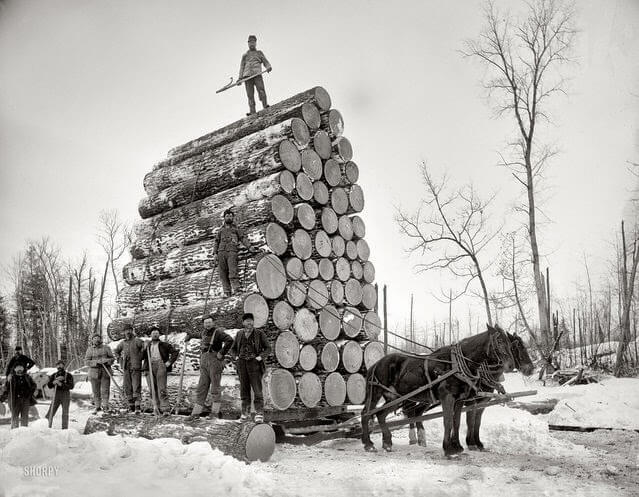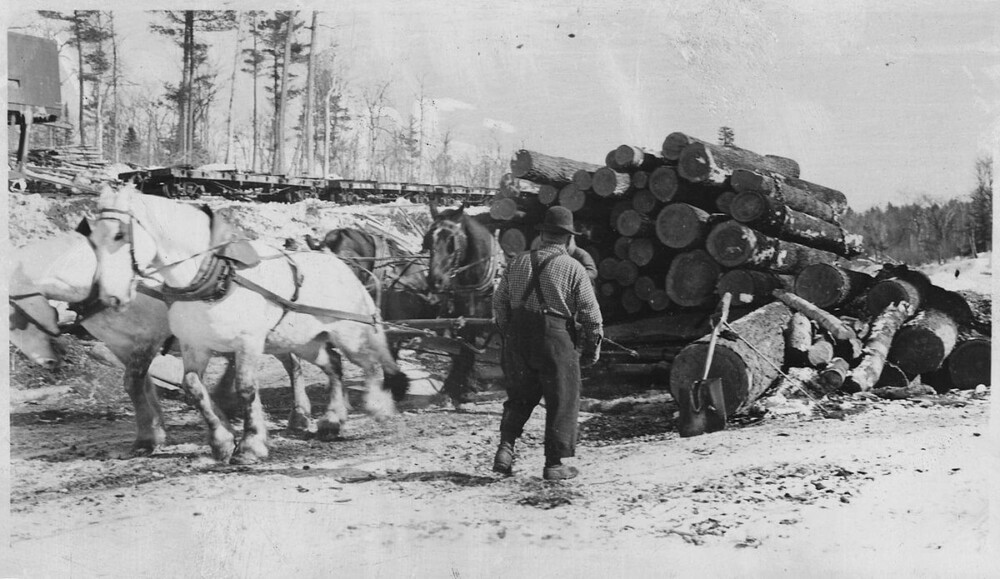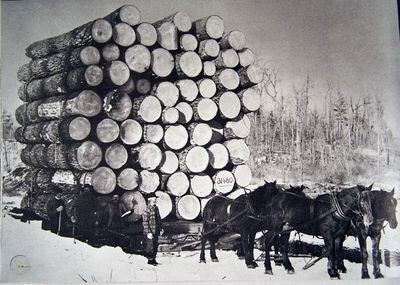For thousands of years, horses have pulled heavy loads. Historically, horses hauled artillery wagons, survival supplies and carried military riders into battle. In the 1800s, horses pulled plows, transported goods from one town to another, and were valuable burdens for various manufacturing processes. Today, many draft horses still work on farms, compete in pulling competitions, and drive with carriages and wagons.
How much weight can a horse pull safely and regularly? An average harness-trained horse can safely pull up to twice its body weight when pulling a well-balanced wagon or cart over long distances. Draft horses can pull three times their body weight, as they have been bred specifically for their pulling abilities.
When horses pull dead weight on a sled or skid that does not have wheels, the amount of weight they can safely and efficiently pull drops to around 15% of their body weight.
Over the centuries, certain breeds have been bred and trained to pull incredible amounts of dead weight for short distances. Today, horses demonstrate their abilities at competitions known as horse pulls. In these competitions, horses pull up to four times their body weight. The distances are very short. And, the horses have been trained extensively for this level of physical exertion.
Additionally, the physical condition of a horse is essential. Horses are trained with lighter weights until their muscles are conditioned to pull heavier weights.
As their muscles strengthen, they can pull greater weight over longer distances. Temperature plays a role in how much weight a horse can pull. Extremely hot and humid days make it hard for horses to cool themselves. The risk of heat stress and exhaustion greatly increase.
Historical Weights Pulled By Horses
Today, few horses are needed to pull as much weight as they were generations ago. Horses and oxen were the two commonly used beasts of burden throughout history. While both horses and oxen could pull similar amounts of weight, horses could do it at a much faster pace.
Oxen are much slower and often kept for agriculture work such as plowing. Horses were a common choice for pulling delivery wagons between towns.
Before automobiles, horses were used to pull a wide range of weights. Many pulled a few hundred pounds (135kg) for a small delivery cart holding newspapers. Others could pull a fully loaded 30,000 pound (13,607 kilograms) wagon hauling coal or other industrial resources to a manufacturing factory. Historically, owners didn’t often keep records that tracked the maximum weights horses pulled. Today’s horses aren’t needed as frequently to pull heavyweights, so they are often loaded with less weight for safety reasons.
Traditionally, horses worked in a single hitch, in teams of two, or four, to get more pulling power. Additionally, multiple horses stationed on both sides of a waterway could haul fully loaded barges through canals in the United Kingdom. This was done to get valuable goods closer to the consumer or refining factories.
Best Horse Breeds For Pulling Heavy Weight
Many horses were explicitly bred for generations to pull extreme weights over both short and long distances. These horses are known as draft, or draught, horses.
They are usually recognized by their extremely thick bones, short backs, and thick necks. These features give them the physical build needed for hard labor. Their shoulders are extremely broad, giving them a large surface area for harnesses, and their feet were wide, ensuring good traction on various ground types. Some of the most common draft breeds known for their pulling ability include:
Belgian Horses: Heavy Workload
While their exact history is somewhat unknown or debated by many horse people, the Belgian horse is one of the most commonly used draft horses in the world today. They are noted for their incredible pulling abilities. These thick-bodied horses can pull some of the heaviest loads around.
Belgians are extremely common in competitive pulling circuits. You can find them in communities that still rely on horses for plowing fields and other farm-based labor. Belgian horses stand 17 hands high and can weigh more than 2,400 pounds (1,088kg). Despite their large size, Belgians are easy to work with and can be managed by teenagers and seniors. Their calm disposition makes them a very safe and hard-working horse to have.
Percheron Horses: Versatile Carriage Haulers
The Percheron originated in France and was first bred as a warhorse. They quickly became an excellent all-around choice for pulling carriages, industrial equipment, and delivery wagons. Today Percheron horses are mainly used for pleasure driving horses and competition. That’s due to their eagerness to please and their elegant shape and build.
Percherons are massive in size, standing up to 18 hands high and weighing 2,600 pounds (1,179kg) or more. Their coats can come in a wide range of colors and patterns making them an attractive horse to look at. As a result, there are dozens of shows and competitions worldwide that focus on this breed exclusively.
Shire Horses: Tall and Hard Working
The Shire has held the record multiple times for being the tallest horse in the world. This breed has made its mark on history in many ways. Its exact lineage is unknown, but the breed originates in the United Kingdom and was used as an all-purpose draft animal.
Their span of uses ranged from hauling barges and pulling brewery wagons to working in the logging and agricultural sectors. Shire horses have the ability to pull a large amount of dead weight, making them highly valuable even today for logging and skid work.
Additionally, they are commonly used for pleasure driving as well as agricultural labor. Some of the largest shire horses have measured at more than 21 hands high, and can weigh more than 3,300 pounds (1,496kg).
The highest record noted in the Book of Draft Horses, the Gentle Giants That Build the World (Amazon) is of a pair of Shires that pulled 100,000 pounds. Others claim they pulled a mere 90,000 pounds. The accuracy of this claim cannot be confirmed because of the absence of many historical records.
Clydesdale Horses: Memorable Wagon Haulers
The Clydesdale is easily the most well-known breed of draft horse today. Clydesdale horses are notable as being the horse of choice for the Anheuser-Busch Brewing Company’s promotional tours. Their full hitch of 8 horses has traveled around the world and has promoted not only the brewing company but the Clydesdale breed.
Clydesdales originated in Scotland. They were used to pull coal cars outside of the mines and move wagon loads of industrial products along the roads. Since they have become a respected and highly appreciated breed used for pleasure driving and competitive pulling teams.
Standing up to 18 hands high and reaching 2,200 pounds (997kg) or more, the Clydesdale is an extremely large and impressive animal.

Ardennais Horses: Elegant and Versatile
Historically used as a horse of war, the Ardennais could be seen pulling artillery wagons. They were ridden into battle as heavy cavalry units. In modern times, owners swear by the Ardennais’ excellent disposition and high level of intelligence. This intelligence and willingness to work make them the perfect choice for utility work such as logging.
Ardennais are not extremely tall but are very stout in build. Standing up to 16 hands high and weighing more than 2,000 pounds (907kg), the Ardennais is the epitome of power. Today, they are commonly used for pleasure driving, logging, and horseback gymnastics.
Small Horse Weight Pulling Abilities
Small horses are breeds that can have members of the species within the pony size limit, but they are still considered horses. Some examples of small horses can include:
- American Quarter Horse: Some individuals can mature less than 58 inches tall. Quarter Horses are rarely used to pull heavier than average weights. They can pull between 1,800 and 2,400 pounds (816 and 1088kg).
- American Paint Horses mature between 56 and 64 inches tall. They are not considered ponies although they can be small on average. These attractive horses can pull about 2,000 pounds (907kg).
Pony Weight Pulling Limits
According to most horse registries, a pony is a horse that stands more than 34 inches tall, but less than 58 inches.
- Shetland
Considered a true pony, Shetlands rarely get larger than 46 inches tall. They have a stocky build and are commonly used under harness for both pleasure and utility driving. They can pull between 800 and 900 pounds (362 and 408kg). - Connemara
Standing between 50 and 58 inches tall, the Connemara is another example of a true pony. These elegant horses are much more refined in comparison to the Shetland and can be used for riding as well as driving. They can pull up to 1,000 pounds (453kg).
Ponies and small horses are just as capable of pulling weight as their larger relatives. In fact, some argue that due to the lower center of gravity, a well-conditioned pony can pull more weight per pound than a full-size draft horse.
Commonly seen in the pleasure driving circuits, ponies can make an excellent choice for both children and adults to work with. Depending on the breed, you can find a spirited and eager pony that is ready to work, or a calm and reliable one to help you practice harnessing and pleasure driving skills with.
Check out The Absolutely Best Pony Breeds.
Miniature Horse Pulling Capacity
Miniature horses are the smallest horses around, maturing less than 34 inches tall. Like their larger counterparts, miniature horses can be trained to safely pull wagons, carts, and supply skids.
Since mature miniature horses usually weigh less than 350 pounds (158kg), the amount of weight they can pull is of course much less than full-size draft horses. However, due to their lower center of gravity, it is common to see a miniature horse pull more weight per pound than a draft horse.
When fitted with a proper harness and hooked to a wagon or cart in good working order, a trained miniature horse can pull three or even four times its own body weight. It’s extremely common to see a single miniature horse pulling a small cart with two adults in it.
The most important thing to keep in mind is that the load in the cart should be well balanced over the wheels. If the weight is too far forward from the wheels, it will push down on the horse’s back and could cause physical injuries.
If the weight in the cart is too far back from the wheels, it can lift up on the harness and prevent the miniature horse from getting proper traction on the ground. This can lead to muscle strain and accidental falls.
The Weight Horses Can Pull By Breed
| Breeds | Average Weight Pulled | Weight Pulled by Teams | |
| Heavy Draft Horse Breeds | Belgian, Percheron, Shire, Clydesdale, Ardennais | 6,000 pounds plus (some records indicate as much as 8,000 lbs) | 18,000 – 22,000 pounds in pairs. The world record is even higher. |
| Average Sized Horse Breeds | Quarter Horse, Paint Horse, Appaloosa, Arabian, Morgan | 2,000 – 2,500 pounds on level ground with a proper wagon | 7,000 pounds in pairs. Teams can pull much more. |
| Ponies | Shetland, Welsh, Connemara, POA, Highland | Around 900 pounds depending on the size of the pony itself. | 2,200 pounds or more in pairs. Pony size plays a part. |
| Miniature Horses | Any horse standing less than 34 inches tall | 500 – 700 pounds on level ground and in proper harness. | 1,000 to 1,400 pounds for pairs. |
Extreme Horse Pulling Competitions
Within North America, there are a variety of horse pull competitions every year. These competitions have teams of two draft horses pull as much weight as they can over short distances. This weight can either be in the form of multiple stone blocks stacked on a skid, or more commonly, the pull force of the horses can be measured with the use of a purpose-built dynamometer. The horses are hooked up to the load and asked to pull it as far as they can or up to 30 feet, whichever comes first.
In 2012, a team of two Belgian horses set the current world record of being able to pull 13,400 pounds (6,078kg) of dead weight a distance of more than 14 feet (4.26 meters). This pair of horses weighed 5,474 pounds (2,482kg) together and had been training for years specifically for this purpose. As of 2021, this record has yet to be broken within North America.
Extreme horse pulling competitions are exciting for everyone involved. Since every pull is highly regulated, it is a safe challenge for both horse and owner. Like any human athlete, draft horses used in horse pull competitions must be trained well and worked on a daily basis to prevent muscle injuries or joint damage.
Ponies and miniature horses can also join in horse pull competitions. These can either be specific competitions for these smaller horses or can be in combination with full-size draft horse pulls. For the most part, however, miniature horses are usually shown at their own competitions since a relatively large number of miniature horse owners train their animals for this.
Horse pull competitions can be found throughout the United States and in Canada. Additionally, the sport has started to gain traction in the UK and throughout Europe. It originally started as a way to display the pulling power of a good plow horse. Now competition has turned into a way to show the incredible abilities these horses have.
Factors that Influence Pulling Abilities
The horse itself is not the only factor that needs to be taken into account. There is a wide range of other conditions that can make a horse more effective at hauling dead weight or moving a wagon.
Horse Physical Condition
A horse that has been trained for harness work and is in good body condition will pull more than an untrained horse. As a horse pulls weight, it develops more muscle clusters in the shoulders, back, and hind legs. More muscle in these areas of the body directly correlates to a higher ability to pull heavy loads.
Ambient Temperature
A horse will not be able to pull heavy loads in extremely hot or cold temperatures. High summer temperatures and increased humidity make it difficult for a horse to regulate its body temperature. Working under these conditions can lead to heat exhaustion.
In the winter, a horse should be asked to move around on a lunge line to bring his body temperature up to a suitable level. If a horse is made to haul heavy loads while its muscles are cold, the risk of muscle strain and tearing increases exponentially.
Ground and Roadways
The surface a horse is on can also directly affect the ability to pull heavy loads. A properly shod horse on pavement can get better traction and the wagon will move much easier too.
Hard-packed dirt or grass provides decent traction for the horse but can add extra friction to the wheels of a wagon. Additionally, a fully loaded wagon may sink into the ground which means the horse must exert more energy to move it.
Muddy ground, loose gravel or wet cobblestone can cause a variety of traction issues for the horse. Mud and gravel can also bog down the wheels of a loaded wagon. Horses forced to work on the slippery ground are ineffective and also risk injuring themselves by falling.
Hills and Terrain Slope
It’s much easier for a horse to pull both dead weight and a loaded wagon across level ground. As a horse is made to move the load up or down a hill, it becomes more difficult. The higher the grade of the hill, the more difficult and dangerous it can become.
Uneven or sloped terrain can be an issue too. Wagon loads can shift or tip to the side, slamming the wooden or metal swing tree into the horse’s back legs. This can potentially break the harness entirely. Not to mention risking physical injuries to the horse itself.
Conclusion
Horses of all sizes can pull incredible amounts of weight relative to their body size. Whether it’s working the fields with a plow, pulling the family through the snow on a sleigh, or putting their power to the max with competitive weight pulling. As long as a few safety precautions are kept in mind, such as a properly fitting harness and a well-maintained wagon, your horse can help out around the farm while also being a beloved companion.
My Favorite Equine Resources For Horses and Donkeys
This list contains affiliate products. Affiliate products do not cost more but helps to support BestFarmAnimals and our goal to provide farm animal owners with accurate and helpful information.
Squeaky Chicken Toy is hilarious to watch and the horses love it! It’s not super tough so keep it away from dogs.
Dewormer with Ivermectin: I use this for my horses and my goats. Duvet makes a great dewormer. I switch between the Ivermectin one and one like this one so the worms don’t get immune to it.
Manna Pro Apple Flavored Nuggets are a delicious smelling treat that my horses go crazy over.
Equinity Amino Acid Supplement for Horses makes a big difference for any horse that’s struggling with arthritis, hoof issues, or just generally. It’s great for older horses who can’t absorb all the nutrients in their food as well!
Manna Pro Weight Accelerator helps older horses gain weight and stay healthier! This was especially helpful when one of my older horses lost weight over the winter and helped her regain her weight over the summer!
Farnam Fly Control goes on the horse or donkey and will keep the flies off your sweet pet. It makes horses way more comfortable and will keep sores from getting infected as well.
Wound Kote protects sores and wounds. It acts as an antiseptic and helps wounds heal faster. It works on both my horses and goats.




